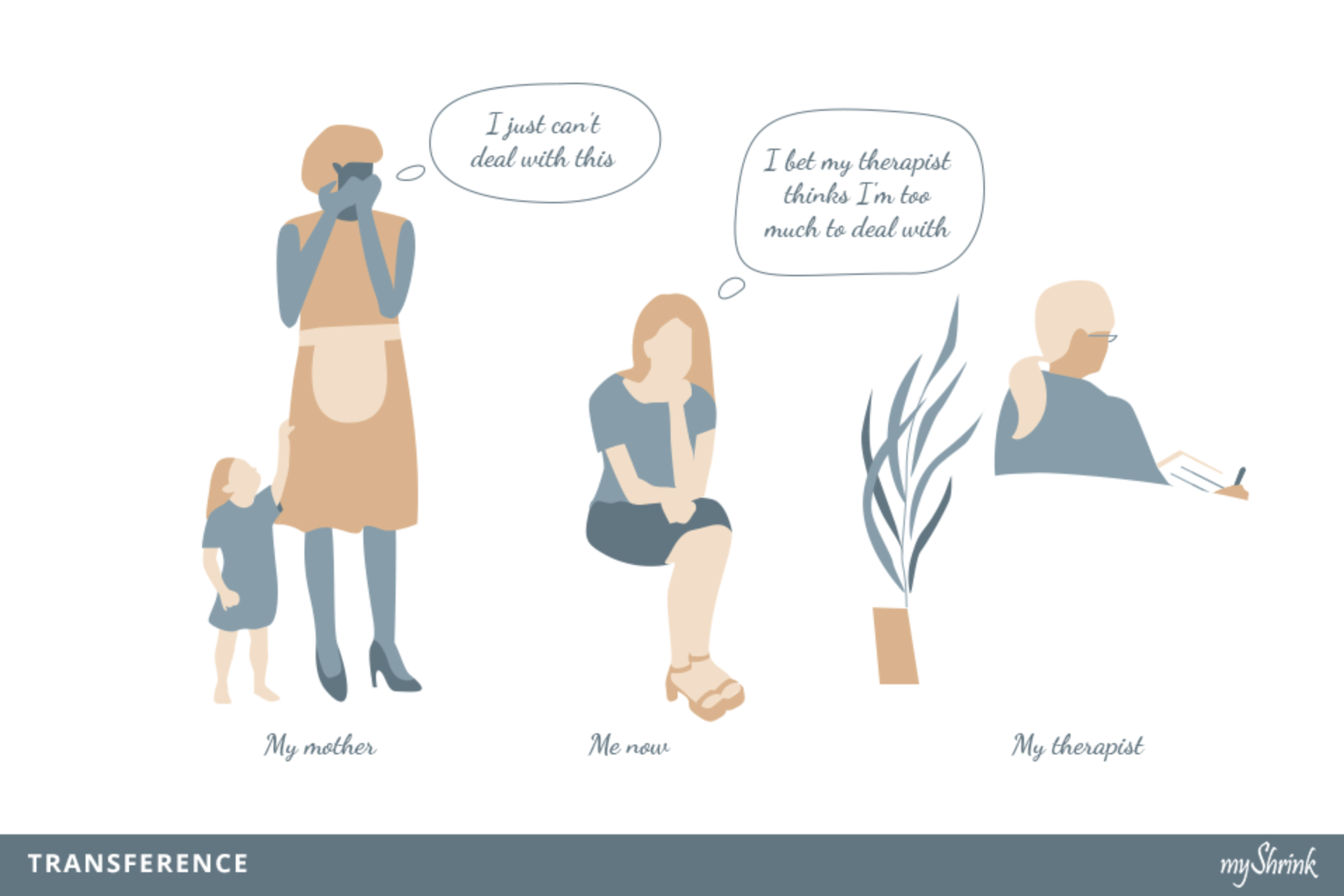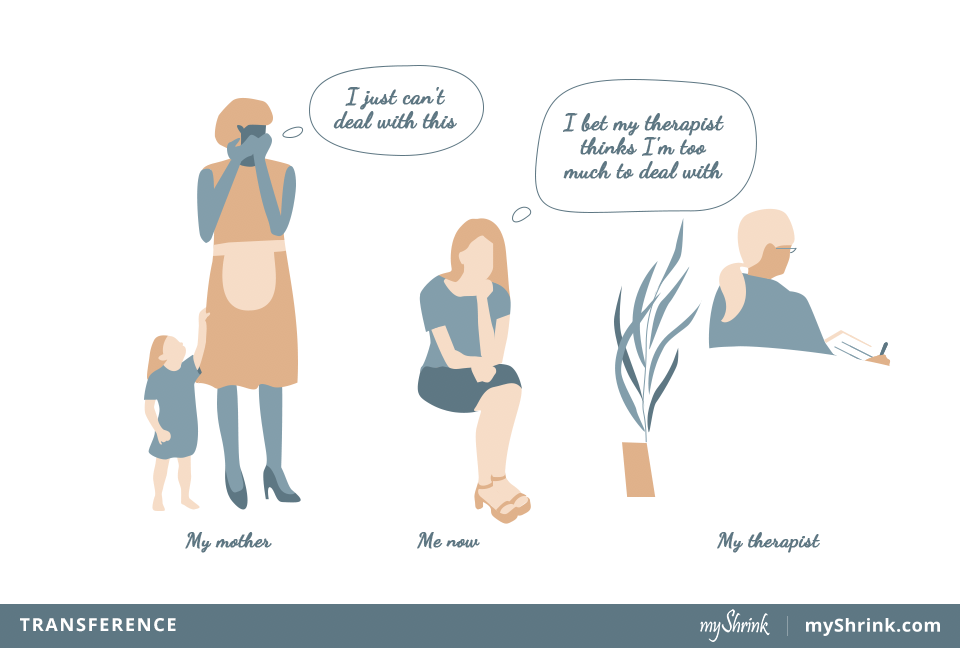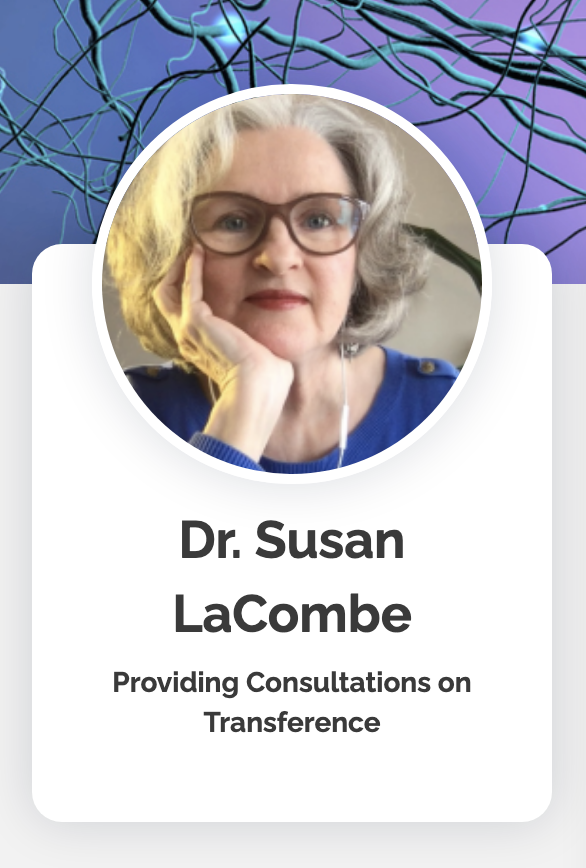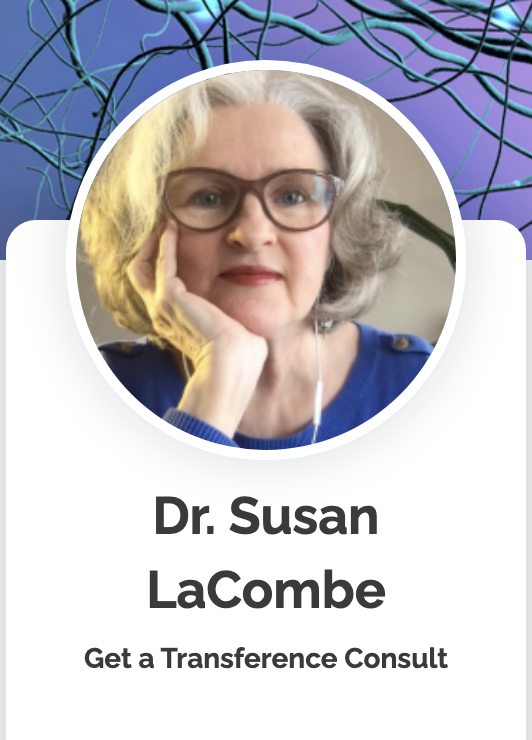(See below for an explanation of how this scene depicts what transference is)
You're wondering what transference is and whether it might explain the feelings you're having. Each time your sessions end, you're left wanting for more.
Can these feelings towards your therapist be real or merely an intricate interplay of your mind?
(Sigmund Freud was right along these lines.)
Hi, I'm Dr. Susan LaCombe, a psychotherapist/psychologist with nearly 30 years of clinical experience.
In 2006, I wrote an article online on dealing with transference. What followed was unexpected yet deeply moving – a flood of earnest messages poured in from clients of fellow therapists.
These messages unveiled what could only be described as 'transference horror stories' . . . many recounted years spent grappling with transference with little relief and without the necessary tools to steer its course.
Others candidly shared the tortuous pain of suddenly being referred to other practitioners still feeling tethered to their original therapist.
Updated: August 13, 2023
This is Part 1 of a 4-Part Series
Part 1: What is Transference (you're here)
Part 2: Typical Transference Examples
Part 3: How to Deal with Transference
Part 4: Tips for Dealing with Transference (Q&A's)
Related: What is Countertransference?
What is transference?
Definition: Transference is the phenomenon where you experience someone (often your therapist, but not exclusively) through the lens of patterns and emotional responses developed in childhood. You end up reacting to this present individual as if they were a significant person from your past.
This reaction occurs because the trigger is usually outside your conscious awareness. You end up believing that the current person is causing your feelings, when in reality, unprocessed memories from your past—such as childhood traumas, stressors, and a lack of attuned care—are driving your feelings and subsequent behavior and attitudes.
Furthermore, if your early relationship with your parents (or caregivers) lacked fulfillment of certain developmental needs, you may unconsciously seek to meet those needs later in life through connections with individuals who resemble your parents in characteristics or roles. (This drive for completion is within us all if we missed out earlier.)
The key to resolving your transference
. . . is to bring these past experiences into the present. By having corrective emotional experiences, or by creating these experiences for yourself**, you can process these emotions and ultimately heal the deep wounds from your past.
**I will acknowledge that it can be very challenging to do this work on your own. It's often much easier to have these corrective experiences with someone you trust. However, I've been practicing these techniques personally for some time and have benefited greatly (not to mention having used them with clients for over a decade). It’s empowering to know that I always have these tools in my toolkit, giving me confidence and resilience.
Understanding What Transference Is
Transference in psychoanalysis
Transference was initially only associated with psychoanalysis with thought leaders such as Freud and Carl Jung.
In this traditional scenario, the therapist would intentionally attempt to intensify the transference by creating an artificial scenario whereby the therapist revealed very little of themselves. This discomfort would trigger any transference to arise much faster in the patient so it could be better observed and analyzed.
Historically, the idea behind transference comes from the notion that we in effect "transfer" feelings for one person, onto another.
For example, the psychoanalyst might be uncommunicative (answering questions with another question) or present a blank, emotionally distant face (which makes most people feel uncomfortable). That discomfort in turn, tends to bring out the more vulnerable parts of us.
This discomfort is particularly amped when the therapeutic "rules of engagement" are not spelled out.
Thankfully, as I understand it, analysts today are more engaged with their clients and the transference that emerges is less shrouded in mystery.*
The approach is based on the notion that the cure for the transference is achieved by a therapeutic examination and resolution of the experiences underlying the early memories.
Here's what I believe is involved:
Resolving Transference in Psychoanalytical Therapy
Psychoanalytical therapy, rooted as it is in the theories of Sigmund Freud, aims to bring unconscious processes into conscious awareness. The approach involves some or all of these aspects:
- Identify the Transference: The therapist first helps you recognize and identify the transference (Presumably since you're here reading this article, you already recognize your transference). (A useful step.)
- Explore the Transference: This next step involves noticing how your feelings, attitudes, and behaviors towards your therapist reflects patterns from past relationships, especially those with significant figures such as parents or caregivers. (While I applaud the goal of discovering how unresolved conflicts and unmet needs from your childhood are influencing your current behavior it's important to understand that many of the memories from these relationships are outside your awareness owing to you being so young at the time. That said, it's infinitely useful to assume patterns arising in relationship do so from one's childhood - there's no need to dig them up specifically unless they arise naturally.)
- Working Through: This next step is where you begin to "work through" these insights, repeatedly confronting and understanding your transference reactions. This process involves discussing and re-examining these feelings over time, which it is assumed will gradually diminish their intensity and influence. (I'm afraid that this sounds a bit like trying to talk yourself out of how you're feeling. If it's only "talking" that's happening in your sessions, I feel that it has its limitations.)
- Corrective Emotional Experiences: Through the therapeutic relationship, it's assumed that you'll experience a corrective emotional experience. This corrective experience is typically described as: "The therapist provides a consistent, safe, and non-judgmental environment, differing from the patient’s past experiences. This new, positive interaction helps heal the old wounds and reshapes the patient’s emotional responses." (I agree that an experiential event(s) in therapy between you and your therapist is helpful in resolving a transference. However, as described above, It's assumed that this is all that is required. When in fact I believe it's insufficient at addressing specific unmet needs. This is why I believe why many continue to suffer their transference often in silence.)
- Integration: Finally, you integrate these new understandings and emotional experiences into your everyday life. You learn to distinguish between past and present relationships, reducing the likelihood of future transference reactions and fostering healthier interpersonal dynamics. (Yes, this is the happy ending where we hope to avoid projecting our past onto our present. Certainly, a noble goal.)
It's my impression that this psychoanalytic—and largely cognitive—approach does not follow the science of how the brain works nor does it serve the majority of folks suffering through a transference.
Indeed, I believe the risk is that this cognitive approach creates a needless dependency that keeps people stuck.
Editor's Note
Even though I recognize some limitations with how psychoanalytic therapy is practiced, please note that I'm also very grateful for the work accomplished by the early pioneers of psychoanalytic theory and what they did for us all.
Recognizing and Managing Erotic and Eroticized Transferences, Darnell Ladson, Randon Wilton, Psychiatry (Edgmont). 2007 Apr; 4(4): 47-50.
ANeuro-Developmental Perspective:
Implicit Memories and Transference
To understand transference from this neuro-developmental perspective you may find it helpful to learn about the role that early memories play. We often refer to them as "implicit memories".
Here's how to understand 'Implicit Memories':
Implicit memories are 'feeling-sense' memories that encompass your recollection of reactions to past real-life events.
You don't normally intentionally try to recall an implicit memory. Rather, implicit memories are most commonly triggered.
Indeed, you can suddenly be experiencing an implicit memory and not know that it is happening. These memories have a knack for slipping through the cracks of your conscious memory, leaving you without a clear recollection of the original event or its timing!
I often share the story of how as a young adult, I'd open the fridge door and suddenly be catapulted back in time to my childhood.
Gone was the ability to put food together. I was filled with the helplessness of a child (ie. seeing the near empty fridge triggered an implicit memory).

The only tool in my kit was to order take-out 🙂
As well, you can have a positive implicit memory as easily as a negative one. These types of memories operate in the background, shaping your responses and behaviors, even when you're not consciously aware of them.

Consider the scenario where a piece of music transports you back in time, evoking sensations within your body and mind.
While you may struggle to pinpoint the exact moment or circumstances of your first encounter with that melody, the emotions it stirs are undeniably genuine.
These feelings are not mere figments of imagination; they're an integral part of these implicit memories that hold an undeniably firm grip on your psyche.
BIG PROBLEM: If you're suddenly experiencing an implicit memory you tend to attribute the feelings as being caused by what's in front of you. You don't have the awareness that a memory from the past is being triggered.
Unbeknownst to you, the emotions presently coursing through you trace back to genuine implicit memories of bygone moments. In an intriguing twist, these sensations undergo a subtle "redirection," finding their outlet through your therapist.
As if fulfilling an age-old quest, your therapist inadvertently assumes the role of the elusive, nurturing "mother or father figure," sparking a profound and intricate connection.

The scene above illustrates how early interactions with parents and caregivers become the basis for relationship patterns in your later years. When these memories remain raw and unprocessed, they readily project themselves onto those who hold significance in your life. (And, often without your awareness.)
A notable illustration of this dynamic is evident in various types of transference (eg. an erotic attraction or believing your therapist has the characteristics of a mother or father figure you never had).
For example, the child above has picked up on her mother's feelings of overwhelm and of the situation being "too much to handle". The little girl internalizes these reactions believing her needs are "too much".
Then later as an adult, whenever she attempts to express her needs it automatically triggers these inner child memories and her tendency is to assume others feel this same way, (ie. "you're asking for too much".)
If you have gaps in emotional "learning" during infancy, then you'll be susceptible to experiencing transference in adulthood (depending which emotional needs went unmet).
Recall psychology 101: If you missed achieving a developmental level, it can be rectified later. As numerous therapists have found (ie. working with hundreds of patients), such is the case with transferential reactions.
The take-home message is that transference is a manifestation—in the present—of events from long time ago where you either . . .
- Didn't get enough chances to learn what you needed to, or
- A traumatic and overly rigid or chaotic home life compelled you to develop strategies that worked in the moment, but in the end stunted your normal emotional development.
GOOD NEWS:
Because the brain continues to "learn" throughout the lifespan, in a sense transference gives you the opportunity for you to "catch up".
Indeed, you can experience a difference in how you feel towards yourself. Your behavior can change for the better. Once a transference is resolved, you might have what some might call, even a fundamental personality change. It's that big.
Introduction to this evolutionary approach
If the brain early on learned a strategy that proved to be less than optimal in adulthood, it can unlearn it.
And if there were learning gaps in childhood we can provide experiences for the brain to get that learning when we reach adulthood.
This positive outlook requires working with the brain and it's normal operation. (There's no sense struggling against the current 🙂
I suggest that you figure out what experiences you need, and then ensure that your brain learns from those experiences.
I know . . . easier said then done.
This 4-Part Series will hopefully help you give you a head start on discovering what transference is from a neuro-developmental perspective.
*Note, I didn't use the term "mental illness". In my clinical experience most issues I've seen are the result of adaptive learning by the brain—at the time. To right the wrong's of the past, it is therefore a case of providing the brain with new healthy experiences it can learn from. (Note that not all "issues" are psychological in nature; some are organic, but fewer than most people realize.)
In the rest of this article we'll explore . . .
Common misspellings: transferance, transferrence, transferrance, transferece.
Going deeper on what is transference
Here's one way of understanding transference . . .
Imagine if your best friend of many years has started acting as if you're just like her domineering father. Suddenly, conversations have a habit of going sideways. She explodes from 0 to 60 in a nanosecond and usually on a tangent that's completely off centre from where you started. It's mind boggling.
And today she wants to bite your head off when all you asked was "how'd you come to choose keto for your diet?"
(Discussions around diets these days can be particularly polarizing. Let's say though that you're genuinely curious as you're considering the same keto diet. What accounts for the 'Jekyll and Hyde' switcheroo in your friend? )
Read on for an intriguing possibility . . . 😉

Lessons learned early - how you impact others - remain with you into adulthood. This little toddler is learning that her needs - that may even be age-appropriate - are too much for her mother. This experience - which probably got repeated many times - is later generalized to other important relationships. (It's very possible that her mother experienced the same treatment at the hands of her mother. Hence, our traumas get passed on.)
Historical relevance
Transference is often used - though not exclusively - in reference to any feelings that arise towards your therapist.
Apparently, it didn't start out that way.
Sigmund Freud first used it as a neurological term. However, by the time he wrote the Interpretation of Dreams he was also using it as a psychological phenomenon.
The turning point was Freud's work with a patient named "Dora". Transference in therapy took on a much larger role after that: "By 1900, transference was ready to stand, as it does today, at the core of psychoanalytic theory."*
*Toward an Intellectual History of Transference, 1988-1900. Makari, G.J., Psychiatr Clin North Am 1994 Sep;17(3):559-70.
Related terms: projective identification, transference neurosis, parataxic distortion.
What is transference in therapy?
Transference in therapy* is the same psychological process described above only the "object" of your projection (ie. where you direct your attention) is your therapist.
In effect you "transfer" your feelings from one person (from your past) onto your therapist. You experience your therapist as if he or she held certain, often idealized, attributes that were either missing or accentuated from your past.
For example, you might experience your therapist as totally 'good'. (ie. He represents the father figure you never had.)
In contrast with negative transference, you experience your therapist as totally 'bad' (ie. the difficult relationship with your Mom gets projected onto your therapist who has now become a mother figure).
In other words, when transference is heightened you tend to experience your therapist in polar opposite ways - either black and white with no shades of grey.
An equally interesting dynamic - known as countertransference - includes the feelings the therapist has towards the client.
Is transference a defense mechanism?
Yes, in conventional psychoanalytical practice, transference is regarded as a defense mechanism. It protects you from deeply rooted emotional pain.
And I would agree with that description.
However, from a neuroscience perspective the brain often operates in less mysterious ways - that is, once you understand what it's ultimately trying to do.
From this perspective transference can be interpreted as the brain is seeking to have a particular experience that it needs to complete its development.
Let me explain.
We know that the brain changes mainly through personal experience. By its very nature, transference also exposes you to an experience - and it's one that you can learn from.
Indeed, once a transference is resolved (ie. it no longer has a hold on you), many people report feeling like an adult, instead of feeling child-like in an adult world.
Transference in relationships
Though the word 'transference' is usually associated with psychotherapy, you can actually develop a transference with anyone.
In fact we all experience transferences to some degree in our personal relationships.
As I mentioned, the term 'transference' was initially adopted in reference to situations where we transfer unmet psychological desires or conflicts onto another person. For example, you might experience your partner’s assertiveness as if she was your critical mother.
That is, you experience the person as if they were just like that other person, and you react accordingly. You're not "crazy" - you do this in an effort to meet a basic psychological need.
That need could be to get closure on an interpersonal conflict that has been brewing since childhood.
Or a transference might arise with respect to a caring health professional who you (subconsciously) feel displays the exact same emotions and attitudes of your mother (or a mother you never had). (See Erin's story)
You experience the other person that way because there's a part of you yearning for experience which were lacking in your emotional upbringing. As a result of this experience, the brain will 'fill the gaps' in your developmental history.
So in this way, transference emerges out of a natural - even healthy - desire to feel whole. Successfully resolving the transference will better equip you to meet your adult needs.
The goal was to "resolve" your transference
It was believed that resolving the transference (ie. working through it) would eliminate the individual's neurotic tendencies and enable him or her to attain happiness.
As with other talk-based theories, it's believed that transformative personal change happens through ‘left brain’ discussion and analysis. (None of that messy emotional stuff. It just confounds the situation 🙂
In other words the theory is, "talking enough about a subject will lead to self-awareness and. ultimately to change."*
Other "talk" type therapies like cognitive behavioral therapy tend avoid the whole issue of transference if it arises.
Unfortunately, the presence of empathy on the part of the therapist is often insufficient to transform a transference. In my view, the interaction between therapist and patient must play out the dynamic at the core of the transference.
*Note: this is a novice' interpretation of psychoanalysis. I had some training in psychoanalytic concepts however I could never profess to be an expert. So if you're really curious, you'll have to do your own research.
Why did transference happen to me?
Many therapy clients that write me tell stories of transference that developed without warning. They had no idea this could occur. (See Diane)
Indeed, the issues they entered therapy for are often quite different than issues that surface related to their transference.
You might be tempted to blame your therapist. Why didn't she warn me this could happen? Did she do anything that made it happen?
Consider this . . .
Transference appears to tap into those gaps in emotional development that are so blended or "normalized" with clients, they do not experience a problem with the core issue.
When emotional problems are so "blended" you don't recognize them as "issues"
For instance, you might describe yourself as easy going. You tend to take a back seat to things, carefully choosing your moments to say anything and avoid saying what you really want particularly if it's a potential conflict with someone else.
That's been generally okay with you cause you'd rather just play it cool and let others decide.
Problem is sometimes you end up feeling used and under-appreciated. That's when you wonder if you have the right friends around you.
The reality is, you've been "training" your friends to expect this of you since you met them.
It's not your fault.
You have an under developed capacity for recognizing, and expressing your own needs.
However, you've adapted. Your unmet needs have "blended" into how you come to experience yourself.
Under the veil of an "easy going" persona you're hiding deep fears of being seen for who you really are: A normal human being with needs.
You're so convincing, you've even convince yourself. You believe that's who you are.
NOT!

Brain Fact: Every function evolved with a purpose.
It may not always be readily apparent, but there’s usually an underlying reason why the brain chooses a certain course of action.
In particular, whatever strengthens you emotionally will help ensure you find your place and survive as a valued member of your social group.
If you keep 'survival of the fittest' in mind in regards to understanding any emotion or any brain function, it'll help you to "normalize" your quirks and make sense of yourself.
'Too much of a good thing'
The "blame game" isn't going to help anyone - including you. I only tell you that so you understand what I'm about to say.
In the above example, the reason you don't usually have a preference one way or another is that you've learned that sensing what you want only causes deep pain.
You see, if your needs were inadequately met or even went unnoticed as an infant then after a while the pain of feeling that need is just too dang hard to feel. (Like an infant crying incessantly wanting to be picked up, you learned it's best not to go there. So in the end you didn't.)
Problem is, if you don't experience a need and then have that same need fulfilled, you won't learn to feel what you want without going into major angst.
An evolutionary perspective
Let's take a basic emotion we've all felt: shame.
Survival of fittest required that we remain aligned with our tribe. The risk of being banished would mean certain death.
Shame is a our built-in "embarrassment" meter that helps us curtail any behaviour that sets us too far apart from the group. Besides it keeps us toilet trained 🙂
Like drinking one too many coffees in a day, the benefit becomes less optimal when taken to extremes.
Inadequate attuned care by a parent can set the stage for overdeveloped shame pathways. This poses a big challenge when it comes to having a solid connections with others.
As in the photo above, the child who is rebuffed enough times later replays this scene in her interactions with her therapist. It's one of the reasons, humiliation towards one's transference plays out in many transferences. (See Suz example below)
(You can imagine for instance, this "greater purpose" means nothing if you share it with your teenage son who happens to "die inside from embarrassment" anytime someone looks at him sideways.)
Let's move forward with your transference
Getting back to transference . . . that's how I want you to view it:
"There's a reason it emerged and even though at this point I can't grasp it's main purpose, I trust that my brain has an agenda."
The trick is to optimize your experience with transference, avoid prolonging it and maximize your time so you get the most bang for your buck.
New! Rate this article (anonymously)
Was this article helpful to you? Let others know.
Thanks in advance for your feedback
Shrinklady
If you're like many people transference popped out of the blue. Suddenly, you lost serious control over your feelings. Worse, your transference seems to go on forever with no end in sight.
And, am I right? Your therapist isn't providing much guidance on getting through. Seemingly, there's no concrete steps you can take to resolve it within a reasonable amount of time.
If these sentiments ring true to you, consider a consult with yours truly.
Click here to learn more.
Related Topics



